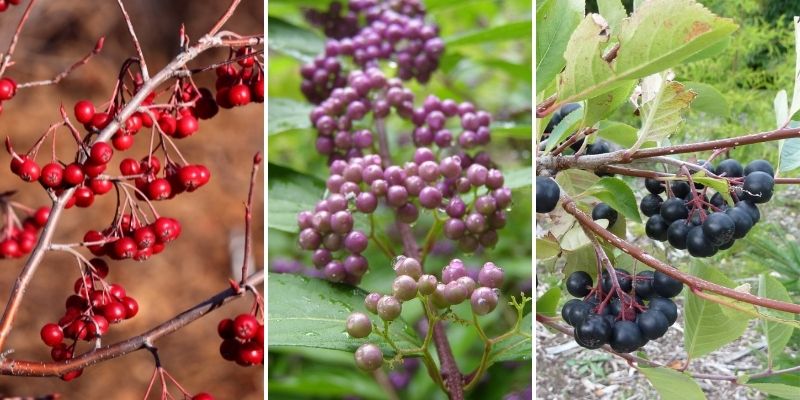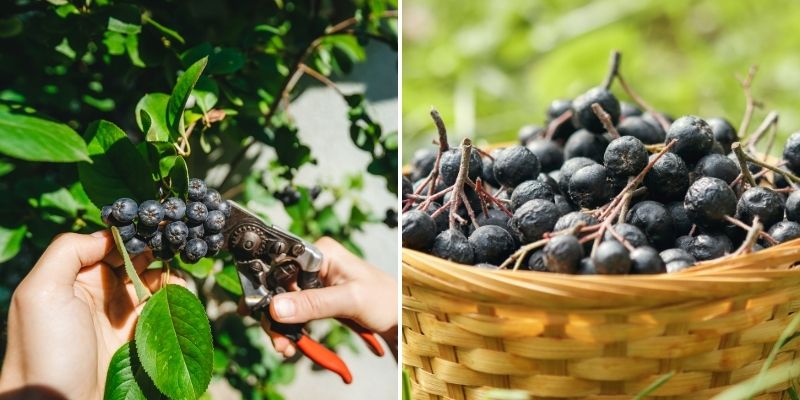Still relatively unknown in France, the Aronia is a bush native to North America that’s worth discovering. Traditionally, indigenous peoples used its berries for both food and medicinal purposes. Introduced to Russia and Scandinavia over a century ago, this plant is cultivated there for its small edible fruits.
Depending on the variety, the berries can be black, purple, or red. Although they closely resemble blueberries, they are more astringent and have a taste closer to blackcurrants. However, when eaten fresh, their flavour isn’t particularly pleasant. This is why Aronia is mostly processed: into jellies, juices, dried berries, etc. These berries are credited with numerous health benefits.
Beyond its fruits, the Aronia has several other advantages. This bush, which can grow up to 2m tall, is perfect for creating a windbreak hedge. Highly melliferous, it attracts many pollinators in spring during flowering and, in autumn, its foliage turns a stunning deep red-purple hue. It isn’t very demanding regarding soil type and thrives in sunny or partially shaded spots. In short, a bush worth adopting!
Here are some tips for drying these precious berries.
Which varieties to choose for consumption?
While the three main types of Aronia – with red (Aronia arbutifolia), purple (Aronia prunifolia), or black (Aronia melanocarpa) berries – are all edible, the purple and black-berried varieties are generally preferred. In fact, Aronia prunifolia 'Nero' and 'Aron' are the most commonly cultivated varieties for consumption.

Aronia arbutifolia (photo Mr.TinDC - Flickr), Aronia prunifolia (photo Chris Light - Wikimedia) and Aronia melanocarpa (photo Wendy Cutler - Flickr)
When and how to harvest Aronia berries?
After spring flowering, the corymbs give way to berries that gradually colour over the months. They ripen from late August and can be picked until October.
Harvesting the fruits couldn’t be simpler. Just use secateurs to cut the clusters at the base on a dry day and give them a gentle shake to remove any insects.
Once picked, the berries are separated from the clusters and rinsed under water. They should be processed quickly to preserve their active compounds as much as possible. If you don’t have a large enough harvest to make jelly, for example, the best option is to freeze the berries until you have enough to make what you want, thus preserving their properties.

Cut your berry clusters with secateurs
How to dry the berries?
Once the Aronia berries are picked, they should be washed and thoroughly dried with a clean cloth or absorbent paper. Then proceed to the actual drying of the berries, which is one of the simplest ways to preserve Aronia.
There are three main methods available: sun drying, oven drying, or using a dehydrator.
Sun drying
Sun drying is only suitable for particularly hot and dry regions of the country, especially since the fruits ripen from August to October, quite late in the season. Drying will take several days, even up to a week.
Spread the berries in a single layer on a tray. It’s best to avoid them touching each other, as contact points can encourage mould. Cover with a light cloth to keep insects away. Over the days, turn the berries at regular intervals to ensure even drying. Remove any berries that appear damaged or start to mould.
Oven drying
For all other regions where sunlight isn’t sufficient for proper drying, the oven can be a good alternative, provided it can be set to a very low temperature.
Place a sheet of baking paper on an oven tray, then arrange the berries on it. They shouldn’t touch each other.
Set the oven temperature to 40-50°C; any higher and you risk cooking the fruits, which isn’t our goal here. During drying, leave the oven door slightly ajar to allow moisture to escape. This ensures better drying. The process will take a few hours, likely between 4 and 6 hours.
This is a fairly accessible method but is energy-intensive.
Dehydrator drying
For those with a dehydrator, this method is recommended. The berries will dry evenly and at a low temperature. It’s also less energy-consuming than using an oven.
Place the Aronia berries on one of the dehydrator trays, ensuring there’s space between them for proper air circulation.
Refer to your dehydrator’s manual for the required drying time, as this varies between models.
How to store the berries?
Once dried, the berries should be kept away from air and light in an airtight glass jar. At the first sign of condensation on the walls, remove the berries and consider drying them a bit more in the oven, as this moisture indicates incomplete drying.
The optimal shelf life for dried berries is one year. Beyond this, the fruits gradually lose their flavour and nutritional qualities.
How to use the berries?
Dried Aronia berries can be eaten as they are, as drying mellows their flavour.
They can also be added to muesli, yoghurt, or compote for a vitamin-packed breakfast. More broadly, you can incorporate these multi-benefit berries into all sorts of desserts like cakes, crumbles, and muffins.
→ Discover different recipes and uses in our tutorials: How to make Aronia berry infusion? and How to make homemade Aronia jam?

Aronia berry tart (photo freestocks.org - Flickr)
Benefits of Aronia
In terms of medicinal benefits, Aronia is said to be very rich in antioxidants, even more so than Goji berries, making it an extraordinary ally in preventing certain cancers and cardiovascular diseases.
It may also have a positive effect on hypertension. Not to mention its potential for stimulating the digestive system and immune function.
→ For more information on growing this bush, check out our guide on Aronia: planting, pruning and care



































Comments